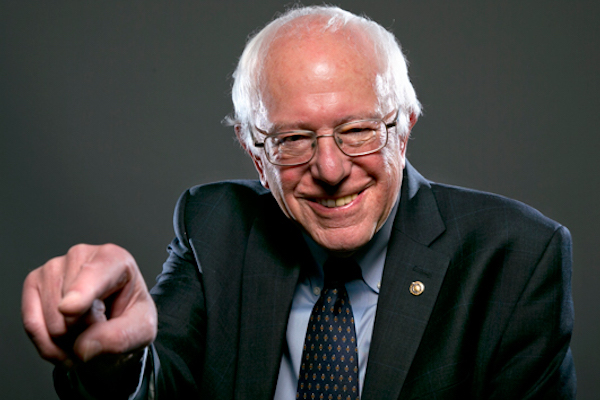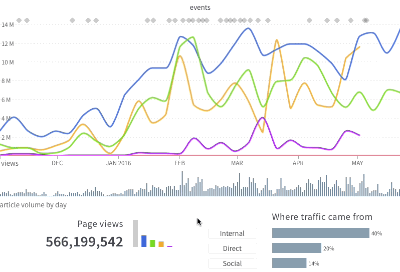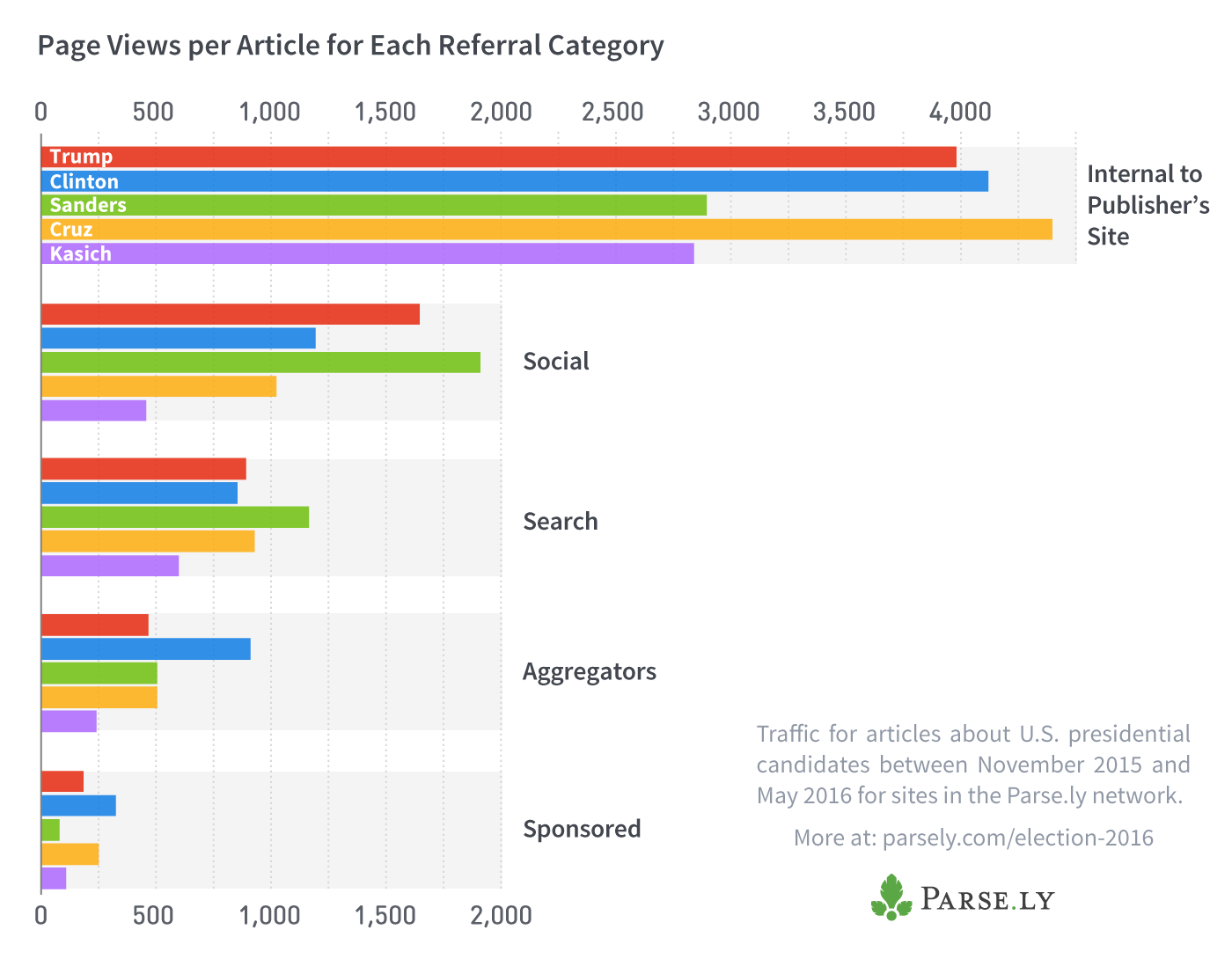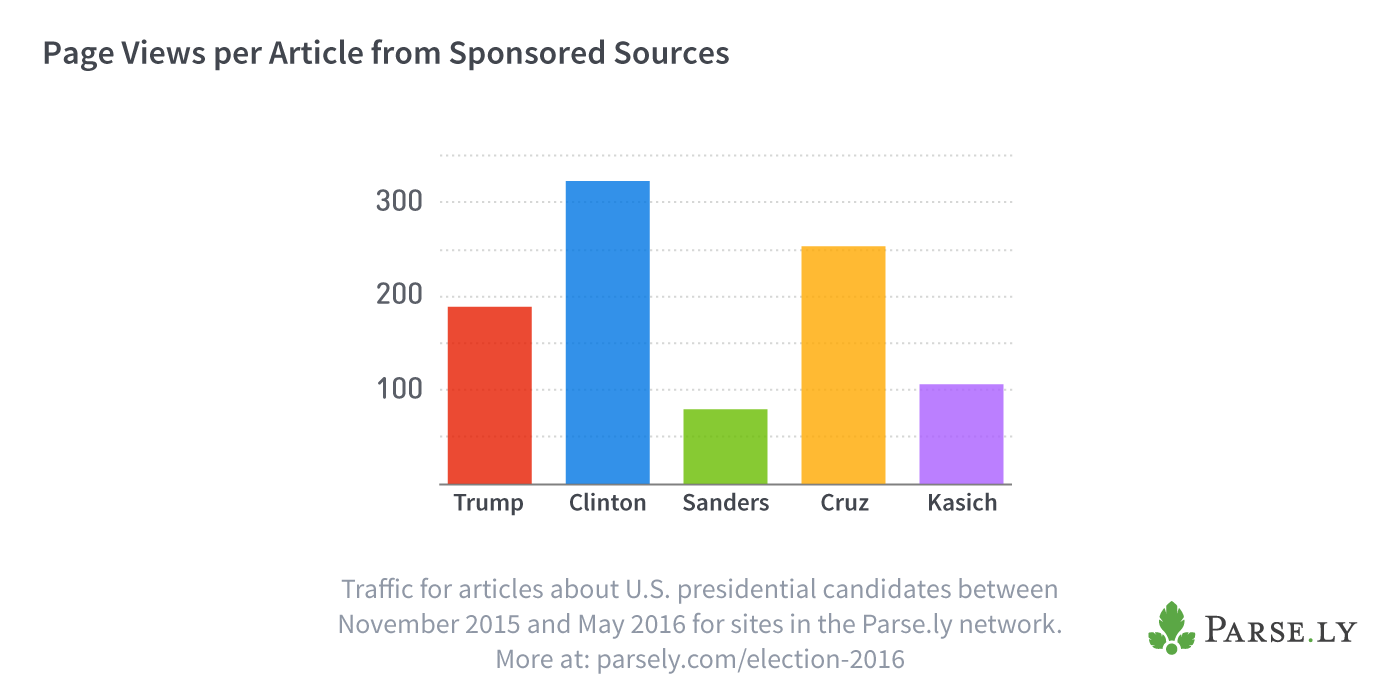Readers are “Feeling the Bern”

Parse.ly recently uncovered new evidence suggesting that the public is not especially interested in reading about Donald Trump, despite the media’s persistence in covering his bid for the presidency.
We learned that articles on Trump, Hillary Clinton, Bernie Sanders, and Ted Cruz received comparable page views per article, which led us to question why the media focused so heavily on writing about Trump. In fact, if the media wants to optimize for page views, then it should start writing more articles about Clinton: a typical article on the former Secretary of State received six percent more page views than a typical article on Trump, and 13 percent more page views than an article on Sanders.

Our election dashboard is automatically updated each week with new traffic data.
However, statistics on page views, alone, omit too much context; they do not show us a complete picture of reader interest. So, we decided to further break them down by referral source to see what additional information we could uncover.
Referral sources provide insight into reader interest
The amount of attention a candidate receives from readers depends on many factors, such as how prominently editors choose to feature the candidate on their homepage, how often readers search for the candidate on Google, popularity on social networks, and how many advertisements point to content on the candidate. Editors, public relations specialists, and sponsored ad campaigns are often accused of manipulating the public to focus “unfairly” on one candidate over another.
In taking a closer look at the referral sources for top candidates in the 2016 Presidential election, the Parse.ly team wanted to see who has benefitted most from editorial decisions, popularity on social platforms, advertising, and reader interest via search engines. The charts below* help tease these factors apart, which we’ll discuss in the following sections.
*All data is derived from an analysis of more than one billion page views across more than 100,000 articles from Parse.ly’s network of digital publishers from November 2, 2015 — May 15, 2016. Our election dashboard is automatically updated with new data on a weekly basis, and therefore may not match these numbers.

An explanation of terms:
- Internal referrals are those which come from a publisher’s site, e.g., clicks generated by a headline on the publisher’s homepage.
- Social referrals are generated by clicks on social platforms such as Facebook, Twitter, and Reddit.
- Search referrals are typically generated by an article being clicked on in search results via search engines like Google.
- Aggregator referrals are generated by clicks on sites such as Google News, Yahoo News, the Drudge Report, etc. that do not create their own content, but instead aggregate content from across the web.
- Sponsored clicks come from visitors clicking on paid ads and are often mediated by services such as Outbrain and Taboola.
Sanders articles drive the most organic traffic per article
By focusing our attention on the search and social referral traffic in the charts above, we are able to take a closer look at organic reader interest — driven by individual readers’ search queries and decisions to share articles on sites like Facebook. You’ll note that a typical article on Bernie Sanders received significantly more organic traffic than a typical article on any other candidate.
Does this really mean that readers are more interested in articles on Sanders than those on Trump and Clinton? Should we blame journalists and editors for manipulating readers to focus on Trump and Clinton by writing far more articles on them and featuring these articles more prominently on their sites? Maybe, but we can’t say that conclusively.
There are other plausible explanations for Sanders’ popularity in search and social. For example, one could speculate that Sanders has a small but extremely active set of supporters who very actively use Google, Facebook, Twitter, etc. to discover and share articles, creating a small but influential echo chamber.
The only way to rigorously explain why Sanders got more organic page views would be to run a complex randomized experiment along the lines of the one that Facebook ran last year. Incidentally, in that study Facebook found that most users are not trapped in an echo chamber, and about one quarter of the articles in a user’s news feed represent an opposing political ideology.
Even without running such an experiment, journalists can still take away the insight that articles about Sanders received the most search and social referral traffic. Such traffic is especially coveted by publishers because it brings external readers to the publisher’s site — traffic which they would not otherwise receive. Internal referrals, on the other hand, come from readers already on their site.
What’s “love” [from your newsroom] got to do with it?
Sanders not only received significantly more organic traffic per article, but he also received significantly less internal referrals than Trump, Clinton, and Cruz. There are two competing explanations for Sanders’ low internal referrals:
- Editors didn’t feature articles on him as prominently in their headline placements on front pages, section pages, and recommendation widgets, so readers had fewer chances to arrive at Sanders articles via internal referrals.
- Editors featured him just as prominently as other candidates, but readers on publishers’ homepages didn’t click on Sanders headlines at the same rate as they clicked on headlines about Trump, Clinton, or Cruz.
Given Sanders’s popularity on social and search, we think that (1) is more likely. In the charts above, you’ll notice that Kasich has the lowest rate of internal referrals. Unlike Sanders, Kasich also has the lowest rate of social and search referrals, so in his case we’d guess that (2) is more likely.
If our theory about Sanders is true, then he might have received even more page views than Clinton if his articles had been given the same priority from newsrooms’ editorial staff. Do you work in a newsroom? What do you think about the type of coverage — and the subsequent promotion of this coverage — that Sanders received from your team?
Weigh in via the short poll below.
A note on sponsored referrals
While sponsored referrals made up a tiny share of referrals overall, they are interesting because they reveal that some candidates are benefitting more from inorganic, paid-for views. These referrals are pretty mysterious because we don’t know who paid for these views — it could be that publishers paid for them, campaigns paid for them, or other benefactors paid for them.

As you can see in the chart above, sponsored referrals were by far most important for Hillary Clinton and Ted Cruz, and least important for Bernie Sanders and John Kasich.
Are you interested in taking a look at Parse.ly’s data to see what trends you could uncover?